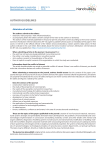Статьи журнала - Nanotechnologies in Construction: A Scientific Internet-Journal
Все статьи: 409
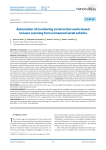
Automation of monitoring construction works based on laser scanning from unmanned aerial vehicles
Статья научная
Introduction. Current publications and technologies for digital modeling of construction projects often entail considerable expenses and lengthy project timelines. In order to effectively monitor and control a large number of objects, there is a need to develop laser scanning technologies specifically for unmanned aerial vehicles, eliminating the need for ground-based imaging. Materials and methods. The study employed a hexacopter-type unmanned aerial vehicle equipped with a laser scanner, as well as specialized software for processing aerial imagery and laser scanning data, which included tools developed by the authors. The octant method was utilized when developing an algorithm for point cloud comparison. Results and discussion. In the course of the study, a technology for automating the monitoring and control of construction work was developed, in accordance with which aerial photography is performed once and an orthophotomap of the object is built (to accommodate laser scanning data). Then, with a certain frequency, laser surveys are carried out from an unmanned aerial vehicle, dense clouds of points are formed for different dates. To compare them, a linear computational algorithm has been developed, which, using data on two dense point clouds, allows obtaining the resulting cloud, which reflects the progress in the construction work. A feature of the algorithm is that the search for points is not carried out over the entire cloud, but within the boundaries of octants. This speeds up data processing and reduces the load on computing power. The technology received software implementation in the web application “Management system for monitoring construction work at facilities that have passed the state examination.” It allows the user to quickly get a visual representation of the change in the construction object for the selected period, to carry out all the necessary measurements (coordinates, geometric parameters, material consumption, etc.). Conclusions. The developed technology for automating the monitoring of construction work can be used by developers, customers, state and municipal authorities to quickly obtain information in order to control and support managerial decision-making.
Бесплатно
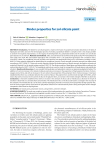
Binder properties for zol-silicate paint
Статья научная
Introduction. The binder for sol-silicate paints is made on the basis of a polysilicate solution obtained on the basis of liquid glass and silicic acid sol. The technological process of creating a polysilicate binder is complex and it is not always possible to achieve the required characteristics. In this regard, the development of a polysilicate binder and the creation of a sol-silicate paint based on it are relevant. Materials and methods. Silicic acid sols Nanosil 20 and Nanosil 30 produced by PK Promsteklotsentr were used in the work. We used sodium liquid glass with a modulus of M = 2.78, potassium liquid glass with a modulus of M = 3.29 (GOST 13078). The conditional viscosity of paints and varnishes was determined using a VZ-4 viscometer according to GOST 8420-74. “Paint materials. Methods for determining the conditional viscosity. Tensile strength (cohesive strength) was determined according to GOST 18299-72* “Paint and varnish materials. Method for determination of tensile strength, elongation at break and modulus of elasticity” on the tensile testing machine IR 5057-50. The silicate modulus of liquid glass was determined according to the method described in GOST 13078-81. The molybdate method was used to study the composition of liquid glasses and polysilicate solutions. Results and discussions. It was revealed that liquid glass and polysilicate solution are typical pseudoplastic bodies. The addition of a sol (an increase in the silicate modulus) promotes an increase in the proportion of high-polymer fractions of siliconoxygen anions (SCA), and with an increase in the sol content, the proportion of the polymeric form of silica increases. It has been established that there is a correlation between the content of silica in the polymer form and the tensile strength of the films, which means that with an increase in the content of silica in the polymer form, an increase in the tensile strength of the films is observed. Conclusions. It has been established that with an increase in the amount of silicic acid sol introduced, a decrease in the pH of solutions is observed at a constant alkali concentration. The introduction of a sol of silicic acid leads to a change in the viscosity of the solutions. The introduction of a sol of silicic acid into liquid glass promotes an increase in the proportion of high-polymer fractions of silicon-oxygen anions. Films based on polysilicate solutions are characterized by faster curing and higher tensile strength compared to films based on liquid glasses.
Бесплатно
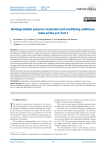
Biodegradable polymer materials and modifying additives: state of the art. Part I
Статья научная
One of the most demanded materials on the planet is plastic, the excellent performance of which contributes to the accumulation of a significant amount of waste on its basis. In this regard, a new approach to the development of these materials has been formed in scientific circles: the production of polymer composites with constant performance characteristics for a certain period and then capable of destruction under the influence of environmental factors. Analysis of the current state of the industry of polymeric materials shows that the most urgent is the use of such classical polymers as polyolefins and polyvinyl chloride. First of all, the optimal solution to this problem due to the lack of a suitable replacement for traditional polymers is the development of composites based on them with the use of biodegradable additives. In this case, a set of problems associated with waste disposal is solved: the decomposition period of the recycled waste is significantly reduced, the territories required for plastic waste are reduced. The paper outlines the preconditions for the emergence and further development of the field of biodegradable polymers. The main quantitative characteristics of the production capacities of manufactured bioplastics by types, regions and industries of application are given. Modern methods of reducing and regulating the degradation time of polymer materials are presented. The main global and domestic manufacturers of biodegradable polymers and their products are listed, as well as a list of the main manufacturers of biodegradable additives for polymeric materials. Modern types of bioplastics based on renewable raw materials, composites with their use, as well as modified materials from natural and synthetic polymers are listed. The main methods for determining the biodegradability of existing bioplastics are described.
Бесплатно
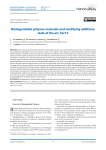
Biodegradable polymer materials and modifying additives: state of the art. Part II
Статья научная
One of the most demanded materials on the planet is plastic, the excellent performance of which contributes to the accumulationof a significant amount of waste on its basis. In this regard, a new approach to the development of these materials hasbeen formed in scientific circles: the production of polymer composites with constant performance characteristics for a certainperiod and then capable of destruction under the influence of environmental factors. Analysis of the current state of the industry of polymeric materials shows that the most urgent is the use of such classical polymers as polyolefins and polyvinyl chloride. First of all, the optimal solution to this problem due to the lack of a suitable replacement for traditional polymers is the development of composites based on them with the use of biodegradable additives. In this case, a set of problems associated with waste disposal issolved: the decomposition period of the recycled waste is significantly reduced, the territories required for plastic waste are reduced. The paper outlines the preconditions for the emergence and further development of the field of biodegradable polymers. The mainquantitative characteristics of the production capacities of manufactured bioplastics by types, regions and industries of applicationare given. Modern methods of reducing and regulating the degradation time of polymer materials are presented. The main global and domestic manufacturers of biodegradable polymers and their products are listed, as well as a list of the main manufacturers of biodegradable additives for polymeric materials. Modern types of bioplastics based on renewable raw materials, composites with their use, aswell as modified materials from natural and synthetic polymers are listed. The main methods for determining the biodegradability of existing bioplastics are described.
Бесплатно

Biodegradable polymer materials and modifying additives: state of the art. Part III
Статья научная
One of the most demanded materials on the planet is plastic, the excellent performance of which contributes to the accumulationof a significant amount of waste on its basis. In this regard, a new approach to the development of these materials hasbeen formed in scientific circles: the production of polymer composites with constant performance characteristics for a certainperiod and then capable of destruction under the influence of environmental factors. Analysis of the current state of the industry of polymeric materials shows that the most urgent is the use of such classical polymers as polyolefins and polyvinyl chloride. First of all, the optimal solution to this problem due to the lack of a suitable replacement for traditional polymers is the development of composites based on them with the use of biodegradable additives. In this case, a set of problems associated with waste disposal issolved: the decomposition period of the recycled waste is significantly reduced, the territories required for plastic waste are reduced. The paper outlines the preconditions for the emergence and further development of the field of biodegradable polymers. The mainquantitative characteristics of the production capacities of manufactured bioplastics by types, regions and industries of applicationare given. Modern methods of reducing and regulating the degradation time of polymer materials are presented. The main global and domestic manufacturers of biodegradable polymers and their products are listed, as well as a list of the main manufacturers of biodegradable additives for polymeric materials. Modern types of bioplastics based on renewable raw materials, composites with their use, aswell as modified materials from natural and synthetic polymers are listed. The main methods for determining the biodegradability of existing bioplastics are described.
Бесплатно
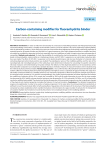
Carbon-containing modifier for fluoranhydrite binder
Статья научная
Introduction. In order to widen the functionality of construction and building materials and widespread electrically conductive building constructions, it is highly recommended to reduce cost of the solutions. This can be achieved by replacing binders with the industrial by-products. At the same time, there are a few articles about adjustment of electrically conductive properties of materials based on by-product binders and this field is of a great importance. Also, highly dispersed particles in modifiers and their role might be considered as important to find out, especially when such additives are used to improve structure and properties of composites. Methods and materials. To study the possibility of controlling the electrical properties of the matrix, compositions based on fluoroanhydrite, sodium sulfate as a hardening activator, and UPC-MIX-1 suspension as an electrically conductive additive, were made. The effect of UPC-MIX-1 suspension on the electrical performance and structure formation of a mineral matrix containing dispersed carbon black particles was studied. The polydisperse nature of the modifying additive and the ratio of the nanodispersed and microdispersed parts of the solid phase were determined. Indicators for calculating the specific volumetric electrical resistance were determined by the probe method. The influence of the dispersed additive on the characteristics of the fluoroanhydrite composite was evaluated by standard laboratory methods. Features of structure formation were evaluated using the methods of physicochemical analysis. Results and discussion. It was confirmed that a fluoranhydrite-based mineral binder with sodium sulfate has moderate physical mechanical properties and might be used as a substitute for gypsum binder. The usage of an electrically conductive additive as a modifier enhances such mechanical properties as flexural compressive strength and compressive strength which increase by 51% and 65% correspondingly. Also, hydro physical properties have been improved, for instance the coefficient of softening for the FD-4 sample has increased by 39%, and the water absorption by mass for the same sample has decreased by 36%. Specific volume electrical resistance has decreased by 49–52% and equals13,6 kOm • cm, 8% of electrically conductive additive being added. The physical and technical properties of the presented composite are due to significant changes of the physical and chemical properties including the features of structure formation. Conclusions. The obtained compositions require extra optimization in order to be used as a heating component. At the same time, the achieved electrical conductivity is sufficient to level the electrostatic effect of self-leveling floors. Regularities in the formation of the structure of the fluoroanhydrite composite have been established, which manifest themselves in the formation of a larger number of contacts for the intergrowth of crystalline hydrate new formations ensured by the presence of a nanodispersed part in the modifying additive.
Бесплатно
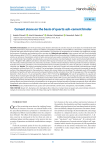
Cement stone on the basis of quartz-ash-cement binder
Статья научная
Introduction. One of the promising areas related to formation of concrete structure on the basis of a mineral binder with specified performance properties employs the addition of ultradispersed fillers (nanomodifiers) to the binder composition. Wastes of quartz and hydro-removal ash are used as nanomodifiers. The presence of nanoparticles in the binder can significantly change the processes of hydration and hardening of the concrete mix. Materials and methods. Hydro-removal ash from Omsk combined heat and power plant 5 (CHPP-5), cement and quartz waste obtained from the production of highly pure quartz concentrate which acted as an enhancer of pozzolanic activity to hydro-removal ash were used as materials for cement stone on the basis of a quartzash- cement binder. Nanomodifier was obtained as a result of mechanical, mechanohydraulic (water) and mechanohydrochemical (water + Megalit S-3ML additive) activations. Activation of the quartz-ash mixture was carried out in a continuous-action rotary mill. The mechanical method provides only mechanical activation, and the mechanohydraulic method provides mechanical, hydraulic, turbulent and acoustic activations. The mechanohydrochemical method provides all actions of hydraulic activation including chemical one. Results. The article investigated cement stone on the basis of quartz-ash-cement binder (activated quartz waste and hydraulic ash from Omsk CHPP-5, cement). The technologies of activation of the quartz-ash mixture by increasing the specific surface of the dispersed phase for the production of quartz-ash-cement binder are considered. The obtained results of the weight distribution of particles of hydro-removal ash and quartz before and after activation show that the average size of the nanoparticle diameter is from 25 μm to 1.5 μm and specific surface is 967–7729 cm2/g. Conclusions. The use of nanoparticles in a quartz-ash mixture allows increasing the strength characteristics of cement stone from 23 to 59%. The use of quartz waste from the production of high-purity quartz concentrate and ash hydraulic removal from Omsk CHPP-5 power plant with the introduction of the proposed technologies for their activation allows increasing the formation of cement stone on a quartz-ash-cement binder by increasing the package density and chemical activity of nanoparticles in the processes of phase formation of hydrate compounds, which will reduce intergranular space between non-hydrated cement grains and will improve physical and mechanical characteristics of cement stone.
Бесплатно
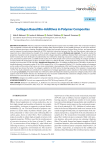
Collagen based bio-additives in polymer composites
Статья научная
Introduction. Polymer composite materials (PCM) based on epoxy resins are widely used in the construction industry. They are applied in construction of bridge spans, roadway slabs, footwalk planks, in low-loaded structures, as well as for reinforcement of concrete structures, sheating, strengthening of metal and concrete structures. Various fillers of micro- and nanosizes are used to improve the performance properties of PCM. Interfacial interaction between the filler and the polymer matrix plays an important role in determining the strength of the created composite materials. Methods and materials. The article studies the properties of polymer matrix composites reinforced with collagen based bio-additives obtained from solid organic waste of the leather industry. We have developed a fundamentally new method for obtaining a bioactive collagen product at a relatively low price, described in patent RU No. 2272808. Tensile studies of the PCM samples were carried out by adding dry collagen powder to an epoxy binder. We analyzed the sections of samples made on a JSM-6510LVJEOL scanning electron microscope, and studied the changes in the structure of PCM with fillers. Results and discussion. When 1% collagen is added to the PCM matrix, the amount of chemical elements is increasing: carbon (C) by 2.93%, oxygen (O) by 1.61%, magnesium (Mg) by 0.11%. And the number of micropores on the surface of the matrix, which serve as a stress concentrator, is decreasing by 4.9%, and they are also diminishing in size. The tensile tests have shown that when 1% collagen is added to the PCM matrix, the bearing capacity of the samples is increasing by 15.57%. The results obtained can contribute to the expansion of collagen application, waste reduction in the leather industry due to recycling. Conclusion. A fundamentally new method has been developed for obtaining a bioactive collagen product from solid organic waste of the leather industry at a relatively low price. It has been established that a bioactive collagen product in a powder form has a low cost and can be used as a bio-additive for PCM.
Бесплатно
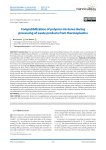
Compatibilization of polymer mixtures during processing of waste products from thermoplastics
Статья научная
Introduction. The recycling of thermoplastic waste into building materials with a long-life cycle is a promising and technologically feasible disposal direction. It is advisable to develop the processing of mixed polymer waste. Thermoplastics are thermodynamically incompatible, and technological compatibility can be controlled at the melt stage by the introduction of compatibilizers and nanofillers, the formation of free radicals in the melt, and reaction compatibilization. Materials and methods. The work aimed to study the effect of a compatibilizer – an ethylene-vinyl acetate copolymer with grafted acrylate and epoxy groups on the properties of composites obtained from mixtures of polyethylene terephthalate and polypropylene waste. The polymer mixture was melted, filled with limestone flour (50–85 wt.%), the samples were pressed, and their physical and mechanical properties were investigated. Results and discussion, conclusions. Differential thermal analysis established the melt preparation temperature of 240оC, which is below the onset of thermal oxidative destruction of the compatibilizer. It was established that the optimal ratio of polyethylene terephthalate: polypropylene: compatibilizer as 70:25:5 wt.% provided the greatest improvement in the bending strength without compromising the compressive strength of filled composites; the optimal degree of filling was found to be 60–70%. The volume fractions of polymers in the mixture are comparable. Therefore, one can expect the formation of both the matrix structure of the composite and the interpenetrating networks type structures. In both cases, the compatibilizer is distributed along the interphase boundaries. Its effect on properties can be attributed to its plastic deformation in the interfacial layer and morphological changes in the structure of the polymer mixture. There is evidence of increased structure-sensitive properties, tensile and tensile strength, of polymer mixtures containing this compatibilizer. This fact indicates an increase in adhesion between polymer phases, which is difficult to explain only for physical reasons. Possible reactions between the functional groups of the compatibilizer and polyethylene terephthalate in the melt with epoxy ring opening were analyzed. An increased effect of compatibility was revealed; however, the actual effectiveness of the compatibilizer is difficult to assess. Additional mechanical tests are required as well as optimization of the melt temperature. It is also necessary to find a balance between activating the reaction compatibilization and minimizing destructive processes in polymers.
Бесплатно
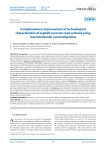
Статья научная
Introduction. The issue of enhancing the long-term performance of asphalt concrete pavement on highways is not entirely addressed by conventional solutions, such as improving the choice of material composition and refining the production process for bitumen binders and mineral filler compounds. One of the most promising ways to improve the performance and durability of asphalt concrete is the complementary modification of bitumen and road-concrete nanocompositions with thermoplastic and elastic polymers. Methods and materials. Bitumen binders are assessed employing suitable methodologies to determine the following technological parameters: extensibility, softening temperature, brittleness, elasticity, and so forth. Asphaltenes of bitumen binders are the most important structure-forming component and form associated nanoclusters with sizes of 15–200 nm. Thermoplastic block copolymers are introduced into the composition of bitumen binders in granular form (chips) or melted form. Additionally, compatibilizers are used to improve the compatibility of complementary copolymers in bitumen binders. The quality of the finished asphalt concrete composition is significantly affected by the characteristics of the main components: mineral powder, sand, crushed stone, bitumen binder and macromolecular nano-additives, as well as by optimal process modes: mixing temperature, etc. Results. The complementary interaction of supramolecular associations of asphaltenes and fragments of macromolecules of polymer nanocomposites ensures the formation of Van der Waals bonds due to spatial mutual correspondence. The introduction of polymer nanomodifiers leads to an increase in the softening temperature and a decrease in the brittleness temperature of bitumen binders due to the formation of sufficiently stable supramolecular complexes. Discussion. Synergistic nanoadditives of complementary macromolecules into the bitumen binder provides a fewfold increase in the adhesion of the bitumen composition and the mineral components, as well as a noticeable increase of the temperature range for plasticity and deformability. Asphalt concrete coatings with polymer-bitumen binders increase the operability of the roadway and resistance to the formation of plastic flow deformations (shifts, ruts) at high and low temperatures. Conclusion. Bitumen binders of asphalt road concrete, which have been modified with polymer nanocomposites, have higher adhesion, an extended range of thermoplasticity and water resistance.
Бесплатно
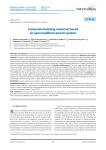
Composite building materials based on nanomodified cement systems
Статья научная
Introduction. This research work investigates the combined influence of nano-sized silicon dioxide (nano-SiO2), carbon nanotubes and surfactants on the structural and technological characteristics of cement compositions. Materials and research methods. The paper reveals the findings of a study on the effects of various dispersion techniques of carbon nanotubes (CNT) in surfactants, such as mechanical dispersion, ultrasonic treatment, and a combined method. It considers the uniformity of CNT distribution within the plasticizer and within the cement system, along with their impacts on the physical and mechanical properties of cement stone and concrete. Differential thermal and electron microscopic analysis of aqueous dispersions of carbon nanotubes and hardened activated nanomodified cement stone was carried out. Results and discussion. It has been experimentally proven that mixing nanotubes in dry cement does not allow them to be evenly distributed throughout the volume of the mixture. When using carbon nanotubes, the maximum effect is achieved when they are introduced into aqueous dispersions of plasticizers. The percentage of plasticizer was 1%, CNT 0,1% per 1 liter of water. The most effective method of dispersing carbon nanotubes in a plasticizer is a combined one. The results obtained were used in the preparation of cement stone and concrete compositions. Conclusion. The results show that complex additives consisting of nano-SiO2 and aqueous dispersions of carbon nanotubes have a positive effect on the physical-mechanical and structural-technological properties of cement stone and concrete. Graphic dependencies are shown indicating the effectiveness of using complex additives in the production of cement composites.
Бесплатно
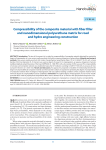
Статья научная
Introduction. The aim of the research is to study the compressibility of composite materials obtained by varying the degree of impregnation of a non-woven needle-punched cloth with an aqueous dispersion of polyurethane. Materials and research methods. Non-woven needle-punched cloth made of polyethylene terephthalate fibers (TU 6-13-0204077-95-91) with a linear density of 0.33 tex (diameter 20–25 microns) was used as objects of research. For impregnation, an aqueous dispersion of anionic stabilized aliphatic polyethiruretane of the brand IMPRANIL DL 1380 (PRC) with a dry residue of 40% was used. The compressibility of canvases and composite materials was established using the ICH indicator according to GOST 577-68 with an accuracy of measuring the thickness of ± 0.001 mm. Results and discussion. An approach is proposed to establish the relationship between the degree of compressibility of composite materials and the load and to obtain an equation for predicting the degree of compressibility of composite materials from the degree of impregnation and load. Optimal loading conditions of the composite material with a minimum degree of compressibility has been established. Conclusion. The optimal degree of impregnation of a non-woven needlepunched fabric made of polyethylene terephthalate fibers with a diameter of 20–25 microns with polyurethane dispersion is 0.5.
Бесплатно
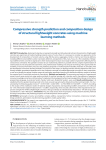
Статья научная
Introduction. Reducing the density, increasing the strength and other physical-technical characteristics of lightweight concretes are urgent tasks of modern building materials science. To solve them, it is necessary to consider new approaches to the development of compositions of cement systems using effective porous aggregates, binders, chemical and mineral additives, including different nanomodifiers (carbon nanotubes, fullerenes, nanoparticles of SiO2, Al2O3, Fe2O3, etc.). The complexity of designing modified cement concretes is largely due to their multicomponent nature and a large number of parameters affecting the key characteristics of material. The qualitative solution of such multicriteria problems is possible with the complex implementation of rational physical and computational experiments using mathematical modeling and computer technology. New opportunities for modeling of structure formation processes and predicting properties of multicomponent building materials are emerging with the development of machine learning methods. The purpose of this study is to develop machine learning algorithms that can efficiently establish quantitative dependences for the compressive strength of modified lightweight concretes on their composition, as well as to identify the optimal variation ranges of prescription parameters based on the obtained multifactor models to achieve the required level of controlled mechanical characteristic. Methods and materials. The processing and analysis of experimental research results were carried out using modern methods of machine learning with a teacher used in the problems of regression recovery, knowledge extraction and forecasting. To implement the developed machine learning algorithms, libraries in the Python programming language, in particular NumPy, Pandas, Scikit-learn, Matplotlib, Seaborn, were used. Results and discussion. It is established that the gradient boosting model is the most accurate type among the obtained machine learning models. It is characterized by the following quality metrics: R2 = 0.9557; MAE = 2.4847; MSE = 12.7704; RMSE=3.5736; MAPE = 11.1813%. According to the analysis of this multifactor model, the optimal dosages of pozzolanic and expanding modifiers amounted to 4.5–6.0% and 6.0–7.5% of the binder weight (Portland cement + modifier), respectively, which ensured achievement of the required level of compressive strength (40–70 MPa) of lightweight concretes at the age of 28 days at material density reduced by 3–10% (the range under consideration is 1200–1900 kg/m3). Conclusions. Thus, the study results show the prospects of using machine learning methods for design compositions and predicting properties of multicomponent cement systems.
Бесплатно
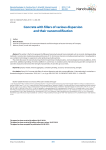
Concrete with fillers of various dispersion and their nanomodification
Другой
The author is the first to propose the filling and nanostructuring of coarse materials such as concrete. Existing grinding methods in construction materials provide particle sizes of 10–50 microns (microns), including cement particles. It is preferable to use cavitation technology in suspensions when producing smaller particles. The article discusses the nanostructuring of cement systems by introducing ultra- and nanodispersed mineral additives. At the same time, additional grinding of mineral additives is carried out at cavitation plants. Nanostructuring provides compaction of concrete structures and increase the strength characteristics of concrete up to 2.5 times.
Бесплатно
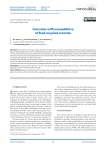
Concretes with nanoadditive of fired recycled concrete
Статья научная
The practice of using recycled concrete from the broken concrete of substandard reinforced concrete products can become widespread in practice. The undoubted relevance of this topic is explained by the program for the renovation of the housing stock in the city of Moscow, which provides for the demolition of 5-storey residential buildings until 2032. The problem of recycling and reuse of construction waste becomes obvious to improve the environmental situation, as well as to reduce the cost of materials in construction and preserve natural resources. The article deals with the nanostructuring of cement systems by means of introduction of ultra- and nanodispersed mineral additives. In this case, additional grinding of mineral additives is carried out in cavitation units. Nanostructuring provides the compaction of concrete structures and an increase in the strength properties of concrete.
Бесплатно

